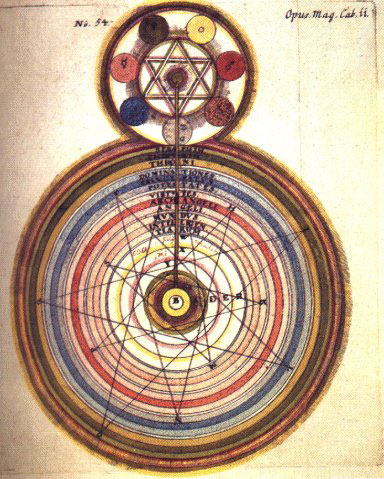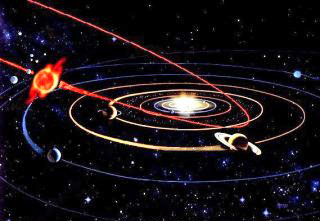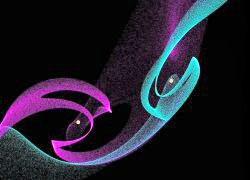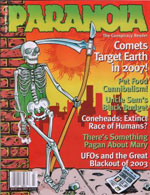|

by
Andy Lloyd
16 December 2004
Iíve been writing about the Dark
Star on the Internet for 5 years this month. During that
time I have come up with a great many ideas, some of which I still
cherish, but others of which Iím fairly certain are just plain
wrong. The Dark Star Theory contains a great many
pages written over these 5 years, and I have not fiddled about with
them. As a result it is still possible to read ideas that have been
jettisoned a while back.
So, this page sets out to present my latest opinions about the
nature of Nibiru; the mythical planet first described by
Zecharia Sitchin in 1976, and to update you as to
where Iím currently at as an author and researcher.
Sitchin described
Nibiru as a terrestrial world occupied by
the Anunnaki that moves
around the Sun in an elliptical orbit of 3600 years duration. The
Dark Star Theory took that thesis and attempted to place it into
some kind of scientific context. I proposed that Nibiru
is a sub-brown dwarf; a failed star about the size of Jupiter which was warm but essentially dark. If the
Anunnaki were to be found, they would live on one of the
terrestrial moons orbits this Dark Star; a moon
warmed by Nibiru itself.

I have also been a strong advocate of a
Messianic timeline for Nibiruís re-appearance
at perihelion. I argued that Nibiru was the Star of
Bethlehem, and offered some strong mythological evidence for
this. In doing so I have relied upon a lot of esoteric knowledge and
symbolism from various sources. This led to a book called íWinged
Disc: The Dark Star Theoryí which I self-published as a bound
manuscript. It sold about 100 copies and attracted absolutely no
interest in the publishing world. But for me it was a great
achievement; perhaps the PhD thesis I never completed, albeit this
time in the field of alternative science, not organic chemistry!
For a couple of years I argued passionately against the í2003
Scenarioí that had propelled íPlanet Xí into the
mainstream media as some kind of whacky Doomsday Cult. My
reaction to that hysteria was to retreat back into the astronomical
science of Planet X exploration, and I came into
contact with many useful people that way. I realized that in order
to maintain credibility for the concept of a Dark Star
I had to evolve the theory further.
The problem was simple: my Dark Star was too
noticeable to be in Sitchinís orbit, yet remain undetected,
and was too massive to pass repeatedly through the asteroid belt
during perihelion. So either Nibiru is a smaller world
than I envisaged, or its orbit was larger. In the end Iíve come to
the conclusion that the orbit is bigger. Sitchinís íSarí
of 3600 years seemed like a pretty neat argument, but Iím now
open to other possibilities.
Furthermore, it seems probable that Nibiru remains
outside the planetary zone for the entire duration of its orbit. Its
only sojourn into an asteroid belt is not the one between Mars
and Jupiter, but the one beyond Neptune, namely
the Edgeworth-Kuiper Belt (known to Americans simply
as the Kuiper Belt).
 Thatís
not to say that Nibiruís initial appearance in the
Solar System wasnít just as Sitchin has written. I think the
Dark Star did indeed crash into the Sunís domain, wreaking
unspeakable havoc 3.9 billion years ago. But over the eons the
affected planets have migrated and settled down into less excitable
orbits. íPlanetary migrationí is a relatively new addition to
the astronomical lexicon, but a useful one for this theory
nonetheless. Thatís
not to say that Nibiruís initial appearance in the
Solar System wasnít just as Sitchin has written. I think the
Dark Star did indeed crash into the Sunís domain, wreaking
unspeakable havoc 3.9 billion years ago. But over the eons the
affected planets have migrated and settled down into less excitable
orbits. íPlanetary migrationí is a relatively new addition to
the astronomical lexicon, but a useful one for this theory
nonetheless.
I started to write this all up for a second book called íBinary
Companioní. But a remarkable thing has happened this year that
has complicated matters greatly:
Science embraced the Dark Star! At least,
indirectly...
 The
discovery of the anomalous extended scattered disc objects well
beyond Pluto have stirred things up a great deal,
possibly more than the equally remarkable íKuiper Gapí. Where
astronomers had theorized that the Edgeworth-Kuiper Belt
should contain a multitude of dull cometary bodies behaving
themselves, the reality has turned out somewhat differently. The
furthest of these objects arenít in thrall to the planet
Neptune as they should be. They have a different master, one
whose presence is undetected. The
discovery of the anomalous extended scattered disc objects well
beyond Pluto have stirred things up a great deal,
possibly more than the equally remarkable íKuiper Gapí. Where
astronomers had theorized that the Edgeworth-Kuiper Belt
should contain a multitude of dull cometary bodies behaving
themselves, the reality has turned out somewhat differently. The
furthest of these objects arenít in thrall to the planet
Neptune as they should be. They have a different master, one
whose presence is undetected.
Astronomers donít really know what to make of this; they have had to
re-model the creation of the outer solar system, and bring other
bodies into play to achieve this.
The best fits published describe close encounters with other stars,
with exchange of material between the Sun and the usurper. It sounds
very Sitchinite to be honest. Unpublished work which Iím
aware of indicates that the presence of a Jupiter-plus size
planet beyond Neptune would fit the observed facts equally well,
possibly better. But the astronomer who has carried out these
calculations hasnít published and cites the lack of that planet
as a problem. Which of course it is...
These developments are very exciting. They provide a good basis for
a re-think of Nibiruís orbit; a wider, longer affair
than previously thought. Maybe this is a step too far for many
Sitchinites. Itís certainly been a struggle for me to accept and
I suspect others will wonder whether the 12th Planet
Theory can actually be said to work if the orbital period is not
a Sar of 3600 years, but something much greater. After
some intensive deliberation I think it can.
 Other
researchers are thinking seriously about the Dark Star.
Barry Warmkessel, for instance, has been researching íVulcaní
for many years. He has recently been published in
íParanoiaí
(Issue 37/Winter 2005) and openly describes
Vulcan as a íDark Starí. Iím pleased about
this as it shows how the various theories out there are starting to
coalesce. Weíre starting to use the same language. In the article
Warmkessel rebuffs the idea that this object could be moving
repeatedly through the planetary zone. Again, our thinking is now
similar, but for different reasons. There is a process of
unification going on. Other
researchers are thinking seriously about the Dark Star.
Barry Warmkessel, for instance, has been researching íVulcaní
for many years. He has recently been published in
íParanoiaí
(Issue 37/Winter 2005) and openly describes
Vulcan as a íDark Starí. Iím pleased about
this as it shows how the various theories out there are starting to
coalesce. Weíre starting to use the same language. In the article
Warmkessel rebuffs the idea that this object could be moving
repeatedly through the planetary zone. Again, our thinking is now
similar, but for different reasons. There is a process of
unification going on.
Another team of researchers are the Binary Studies Institute
who argue that the Solar Systemís centre of gravity
is off-centre due to the pull of the binary companion,
which has repercussions for the Earthís íwobbleí. Their research has
the advantage of serious funding.
 So
my work is that of one among many, which is to be heartily welcomed.
The nearest I have got to being published is through the Paranoia
Publishing group. I have two articles in the book íThe
New Conspiracy Readerí. The magazine íParanoiaí
will also publish my essay íThe True Sun of the Incasí in
their Spring 2005 issue. This publication is fast becoming the
nearest to peer-reviewed journalism about the Hunt for Planet X.
I recommend it to everyone interested in the Dark Star Theory. So
my work is that of one among many, which is to be heartily welcomed.
The nearest I have got to being published is through the Paranoia
Publishing group. I have two articles in the book íThe
New Conspiracy Readerí. The magazine íParanoiaí
will also publish my essay íThe True Sun of the Incasí in
their Spring 2005 issue. This publication is fast becoming the
nearest to peer-reviewed journalism about the Hunt for Planet X.
I recommend it to everyone interested in the Dark Star Theory.
I say this because there is some disappointment about my decision to
stop providing íWinged Discí. Iím sure that many
readers have the thought in their minds that being an author is a
rather glamorous and possibly lucrative existence. I certainly did
when I started out. But itís really not. Self-publishing is an
involved, expensive option for those authors with nowhere else to
turn. Itís just so much easier to put web-pages together and publish
them for free over the Internet!
 The
down-side is that many people like to actually read a book, and to
place it onto their bookshelf for future reference. Thatís how I
like to read; I donít have a lot of patience myself for reading
reams of material on a computer screen. In fact, I take it as a
great compliment when readers of my website feedback about its
contents. So even though a proper published book seems some distance
away now, I will continue to build on the theory developed on the
website. I would dearly love to present my new arguments in a
detailed format in a book, but that seems unlikely at the present
time. I can only apologies for my lack of technical expertise in the
field of publishing and business. The
down-side is that many people like to actually read a book, and to
place it onto their bookshelf for future reference. Thatís how I
like to read; I donít have a lot of patience myself for reading
reams of material on a computer screen. In fact, I take it as a
great compliment when readers of my website feedback about its
contents. So even though a proper published book seems some distance
away now, I will continue to build on the theory developed on the
website. I would dearly love to present my new arguments in a
detailed format in a book, but that seems unlikely at the present
time. I can only apologies for my lack of technical expertise in the
field of publishing and business.
Itís been a great honour to write for you all over the last 5 years,
and I look forward to interesting times ahead, of which I shall
endeavour to keep you abreast. I would also like to mention the
invaluable help of other researchers who periodically send me news
items and comment.
There is a collegiate effort involved in this research which spans
the entire world. As the Dark Star Theory reaches
300,000 hits and its 5th birthday I applaud you all.
|


 Thatís
not to say that Nibiruís initial appearance in the
Solar System wasnít just as Sitchin has written. I think the
Dark Star did indeed crash into the Sunís domain, wreaking
unspeakable havoc 3.9 billion years ago. But over the eons the
affected planets have migrated and settled down into less excitable
orbits. íPlanetary migrationí is a relatively new addition to
the astronomical lexicon, but a useful one for this theory
nonetheless.
Thatís
not to say that Nibiruís initial appearance in the
Solar System wasnít just as Sitchin has written. I think the
Dark Star did indeed crash into the Sunís domain, wreaking
unspeakable havoc 3.9 billion years ago. But over the eons the
affected planets have migrated and settled down into less excitable
orbits. íPlanetary migrationí is a relatively new addition to
the astronomical lexicon, but a useful one for this theory
nonetheless. The
discovery of the anomalous extended scattered disc objects well
beyond Pluto have stirred things up a great deal,
possibly more than the equally remarkable íKuiper Gapí. Where
astronomers had theorized that the Edgeworth-Kuiper Belt
should contain a multitude of dull cometary bodies behaving
themselves, the reality has turned out somewhat differently. The
furthest of these objects arenít in thrall to the planet
Neptune as they should be. They have a different master, one
whose presence is undetected.
The
discovery of the anomalous extended scattered disc objects well
beyond Pluto have stirred things up a great deal,
possibly more than the equally remarkable íKuiper Gapí. Where
astronomers had theorized that the Edgeworth-Kuiper Belt
should contain a multitude of dull cometary bodies behaving
themselves, the reality has turned out somewhat differently. The
furthest of these objects arenít in thrall to the planet
Neptune as they should be. They have a different master, one
whose presence is undetected. 

 The
down-side is that many people like to actually read a book, and to
place it onto their bookshelf for future reference. Thatís how I
like to read; I donít have a lot of patience myself for reading
reams of material on a computer screen. In fact, I take it as a
great compliment when readers of my website feedback about its
contents. So even though a proper published book seems some distance
away now, I will continue to build on the theory developed on the
website. I would dearly love to present my new arguments in a
detailed format in a book, but that seems unlikely at the present
time. I can only apologies for my lack of technical expertise in the
field of publishing and business.
The
down-side is that many people like to actually read a book, and to
place it onto their bookshelf for future reference. Thatís how I
like to read; I donít have a lot of patience myself for reading
reams of material on a computer screen. In fact, I take it as a
great compliment when readers of my website feedback about its
contents. So even though a proper published book seems some distance
away now, I will continue to build on the theory developed on the
website. I would dearly love to present my new arguments in a
detailed format in a book, but that seems unlikely at the present
time. I can only apologies for my lack of technical expertise in the
field of publishing and business.